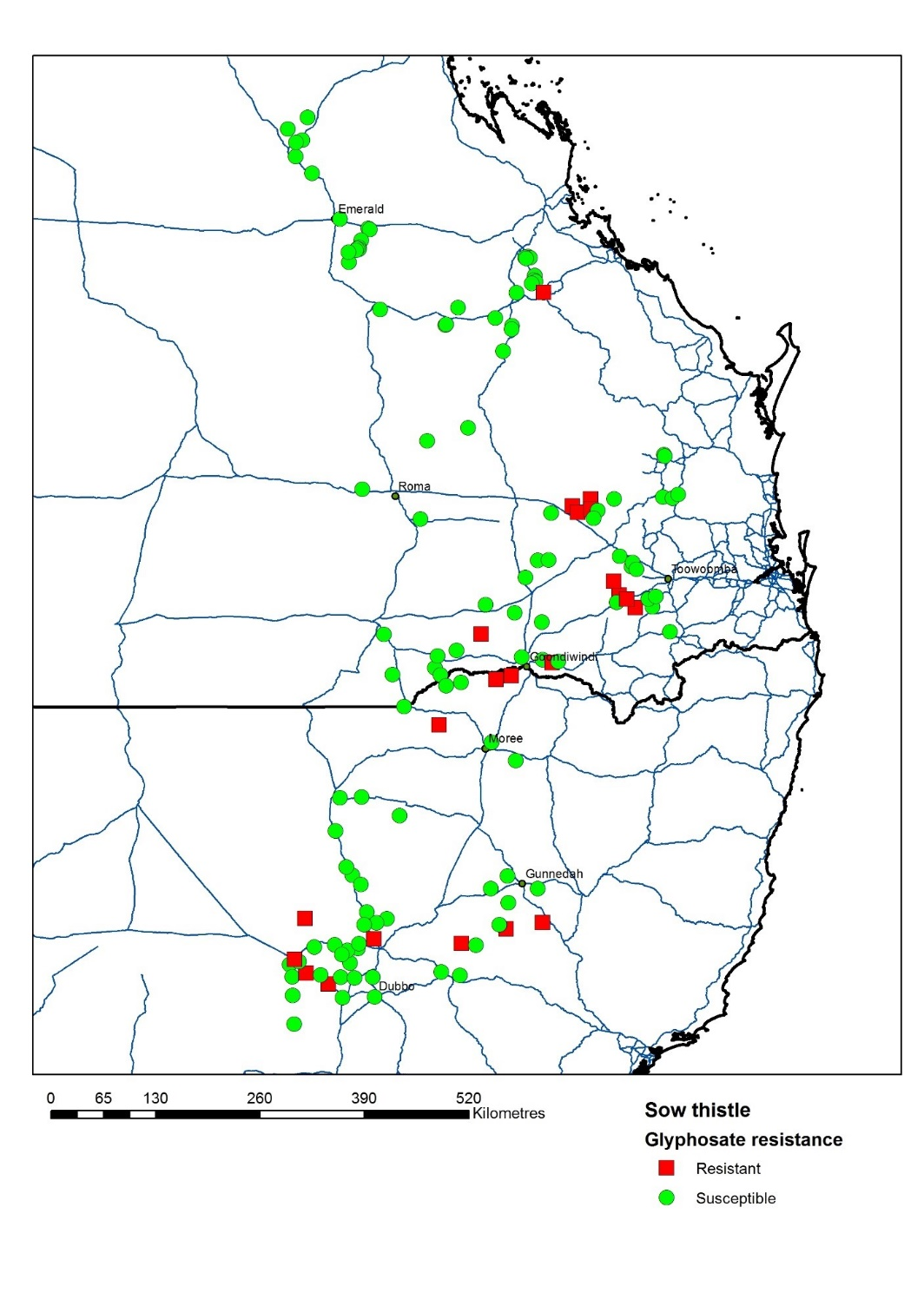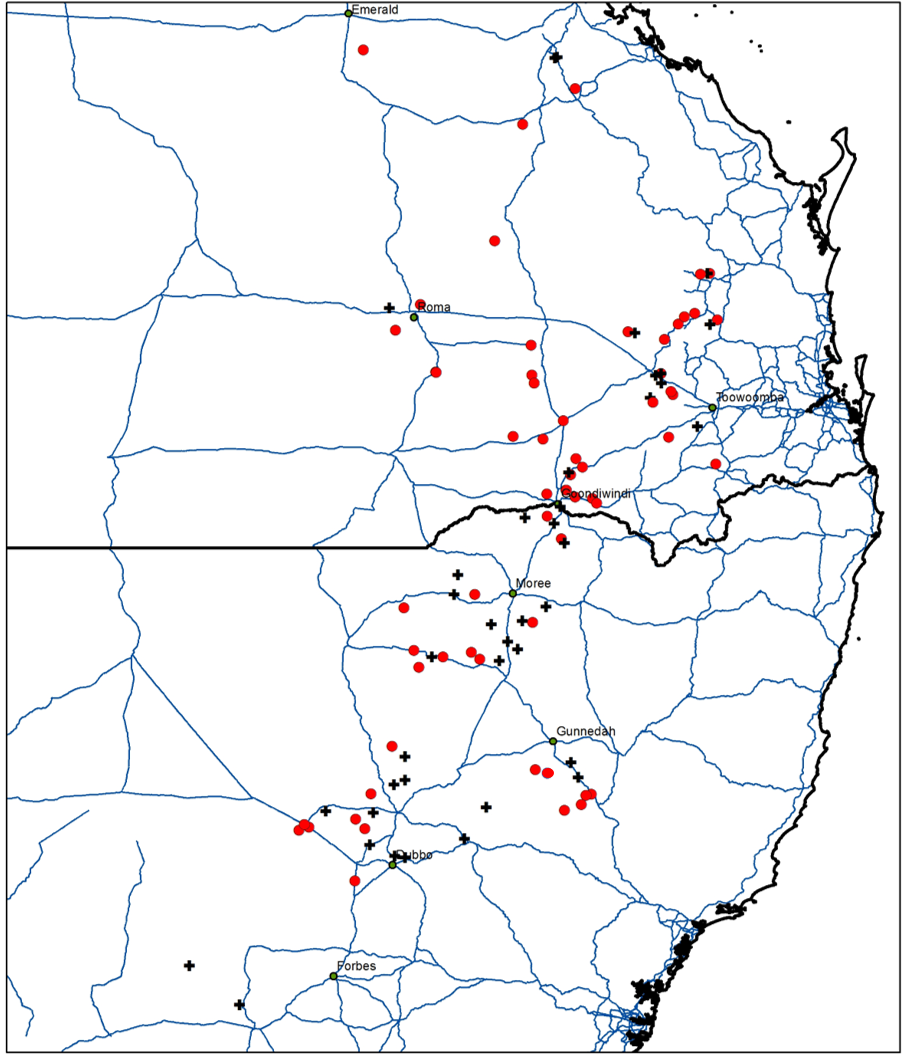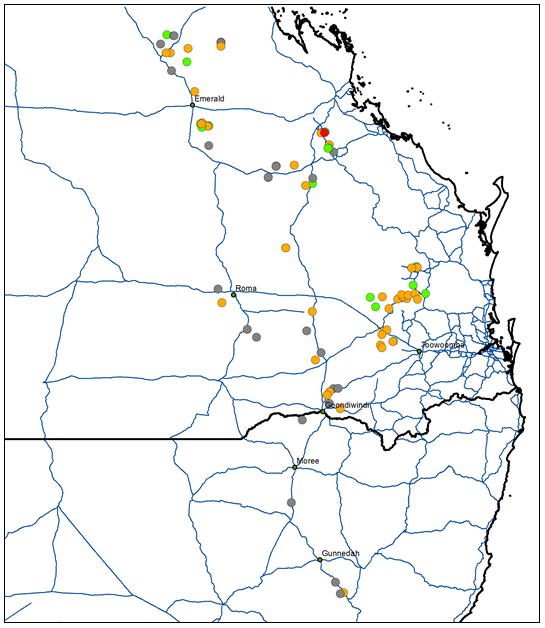Herbicide resistance survey results summer annual weed species: fleabane, feathertop Rhodes grass, barnyard grass, sowthistle, windmill grass
Author: Michael Widderick (Queensland Department of Agriculture and Fisheries), Michael Walsh (University of Sydney), Adam Jalaludin (Queensland Department of Agriculture and Fisheries) and John Broster (Charles Sturt University) | Date: 02 Mar 2021
Take home messages
- Glyphosate resistance is common in the northern grain cropping region: flaxleaf fleabane (100% of populations), feathertop Rhodes grass (68%), windmill grass (58%), awnless barnyard grass (36%), common sowthistle (14%)
- Haloxyfop (Group A) resistance was confirmed in one population of feathertop Rhodes grass and this resistance is likely to become more common under current Group A herbicide use patterns for fallow grass weed control
- 2,4-D amine controlled all fleabane and sowthistle populations, including those that survived glyphosate
- Group A herbicides haloxyfop, propaquizafop and clethodim gave good control of the remaining summer grass weeds and all feathertop Rhodes grass populations were susceptible to paraquat
- Multiple chemical and non-chemical weed control options need to be used to delay herbicide resistance and retain the usefulness of herbicides for weed control.
Introduction
To better understand the extent of herbicide resistance in the dominant summer annual weed species of the northern grain cropping region, a weed seed collection survey was conducted during the 2016-17 and 2017-18 summer grain cropping seasons in summer cropping regions (Qld and northern NSW).
This paper outlines the survey and provides results on which weeds were most common and the herbicide resistance status of key summer weeds including common sowthistle (Sonchus oleraceus), flaxleaf fleabane (Conyza bonariensis), awnless barnyard grass (Echinochloa colona), feathertop Rhodes grass (Chloris virgata) and windmill grass (Chloris truncata).
Material and methods
Random field surveys were conducted across the northern grain cropping region by Queensland Department of Agriculture and Fisheries in conjunction with Charles Sturt University. Field surveys were conducted in February – March 2017 and February – April 2018. A total of 237 paddocks were surveyed in fields with summer grain crops or in fallow.
Surveying involved collecting seed heads from weeds that were present at sampling, which was timed to coincide with crop maturity. At each collection site, GPS-coordinates were recorded along with crop/fallow situation, presence of target weed species and approximate density. Other weed species were also noted to identify weeds for inclusion in future surveys.
Target weeds collected included common sowthistle, flaxleaf fleabane, awnless barnyard grass, feathertop Rhodes grass and windmill grass. These weeds were screened for resistance to the herbicides commonly used for their control (Table 1).
A winter crop survey was also conducted at crop maturity in 2017 and 2018 and the presence and frequency of target summer weed species that were found in winter crops at harvest are presented (Table 2).
Seed germination and herbicide resistance screening
Weed seeds were grown in the growing seasons following their collection. Sowthistle were grown from late March to late November while fleabane and the summer grasses were grown from late November to mid-May.
Plants were grown until they reached three to five leaf stage. They were then treated at the recommended label rate for each herbicide (Table 1) with the appropriate adjuvant (if required). Herbicides were applied using an enclosed cabinet sprayer. For weeds that did not have registration for a particular herbicide, recommended rate for the closest relative weed was used. Assessment for survivors was carried out at 21 days after treatment (DAT). Plants were considered surviving if there were actively growing tillers (grass weeds) or regrowth from the growing point (broadleaf weeds). A population was classed as resistant if at least 20% of plants survived treatment.
Table 1. Herbicides and rates used for screening various weed species for resistance.
Weed species | Herbicide (note rates are of active ingredient) |
|---|---|
Common sowthistle | Glyphosate (729 g ae/ha) 2,4-D amine (1050 g ai/ha) Velocity® (bromoxynil 210 g ai/ha + pyrasulfotole 37.5 g ai/ha) Chlorsulfuron (15 g ai/ha) † |
Flaxleaf fleabane | Glyphosate (729 g ae/ha) † 2,4-D amine (1050 g ai/ha) |
Feathertop Rhodes grass | Glyphosate (729 g ae/ha) † Haloxyfop (78 g ai/ha) Clethodim (90 g ai/ha) Paraquat (400 g ai/ha) |
Awnless barnyard grass | Glyphosate (729 g ae/ha) Propaquizafop (60 g ai/ha) Clethodim (90 g ai/ha) Imazapic (96 g ai/ha) ** (post-emergence application) |
Windmill grass | Glyphosate (729 g ae/ha) Clethodim (90 g ai/ha) *** |
†Not registered for control of this weed species
** Used alone as post-emergence. Note that imazapic is only registered for stand-alone use against these weeds as a pre-emergent application. ***As per APVMA permit PER89322 (but without the double knock)
Results and discussion
Weed occurrence
In the northern region, common sowthistle was the most commonly occurring weed, present in both summer and winter crops at harvest time (Table 2). The summer grasses feathertop Rhodes grass and awnless barnyard grass were present in 20% of Queensland fields surveyed but only 3 and 5% respectively of fields surveyed in NSW. Flaxleaf fleabane was less common in Queensland, being present in 11% of summer and winter fields surveyed, compared to 15% of surveyed paddocks in NSW. Sweet summer grass (Brachiaria eruciformis), which was not a target weed, was present in both summer and winter surveys occurring in 9% of fields. These fields were all in Central Queensland.
Table 2. Incidence and frequency of occurrence of major summer weed species in paddocks surveyed during the weed seed collection survey of summer and winter cropping paddocks at crop maturity in 2017 and 2018. Expressed as both number and percent of fields surveyed in the northern grain cropping region.
Weed species | Queensland | New South Wales | ||
|---|---|---|---|---|
No. of fields | % of fields | No. of fields | % of fields | |
Common sowthistle | 97 (W/S) | 26 | 104 (W) | 33 |
Feathertop Rhodes grass | 75 (W/S) | 20 | 12 (S) | 3 |
Awnless barnyard grass | 34 (S) | 20 | 17 (W/S) | 5 |
Flaxleaf fleabane | 42 (W/S) | 11 | 47 (W/S) | 15 |
Sweet summer grass | 34 (W/S) | 9 | 0 | 0 |
Liverseed grass | 8 (S) | 5 | 5 (S) | 2 |
Windmill grass | 2 (S) | 1 | 15 (S) | 6 |
W = winter crop survey, S = summer crop survey.
Common sowthistle resistance
Screening of 197 viable sowthistle populations with glyphosate and 2,4-D amine detected 14% were resistant to glyphosate while 100% were susceptible to 2,4-D amine (Table 3). The glyphosate resistant populations were distributed throughout the northern region (Figure 1). Screening of 136 populations with Velocity® and chlorsulfuron showed that Velocity® was able to control all populations while 95% of populations were resistant to chlorsulfuron (Table 3).
Table 3. Number of collected populations of common sowthistle and flaxleaf fleabane screened for resistance and the frequency of these populations that were resistant to glyphosate, 2,4-D amine, chlorsulfuron and Velocity®.
Weed species | Number of populations tested | Glyphosate (%) | 2,4-D amine (%) | Chlorsulfuron (%) | Velocity® (%) |
|---|---|---|---|---|---|
Common sowthistle | 197 | 14 | 0 | ||
136 | 95 | 0 | |||
Flaxleaf fleabane | 61 | 100 | 0 | n/a | n/a |
 Figure 1. Distribution of glyphosate resistant and susceptible common sowthistle populations across the northern grain cropping region. Red squares represent resistant populations while green circles represent susceptible populations.
Figure 1. Distribution of glyphosate resistant and susceptible common sowthistle populations across the northern grain cropping region. Red squares represent resistant populations while green circles represent susceptible populations.
Flaxleaf fleabane resistance
Of the 89 fleabane populations collected across the northern region, only 61 were viable (Figure 2). Glyphosate alone is not registered for fleabane control and none of the populations screened were controlled by this herbicide (Figure 2). None of the populations survived treatment with 2, 4-D amine (Table 2).
 Figure 2. Distribution of glyphosate resistant flaxleaf fleabane populations across the northern grain cropping region. Red circles are resistant populations, while black crosses represent non-viable populations.
Figure 2. Distribution of glyphosate resistant flaxleaf fleabane populations across the northern grain cropping region. Red circles are resistant populations, while black crosses represent non-viable populations.
Feathertop Rhodes grass resistance
Screening of 62 viable populations revealed 68% survived the glyphosate target rate (noting that glyphosate is not registered for FTR control (Figure 3, Table 4). One population survived treatment with haloxyfop. This population was from north of Biloela in Central Queensland. All populations were controlled with clethodim and paraquat.
Table 4. Number of populations of feathertop Rhodes grass screened for resistance and the frequency of these populations that were resistant to glyphosate, haloxyfop, clethodim and paraquat.
Weed species | Number of populations tested | Glyphosate (%) | Haloxyfop (%) | Clethodim (%) | Paraquat (%) |
|---|---|---|---|---|---|
Feathertop Rhodes grass | 62 | 68 | 2 | 0 | 0 |

Figure 3. Distribution of feathertop Rhodes grass resistances across the northern grain cropping region. A red circle represents a glyphosate and haloxyfop resistant population, orange circles represent glyphosate resistant populations that are susceptible to haloxyfop, green circles represent populations susceptible to all herbicides tested, and grey circles represent populations that were not viable.
Awnless barnyard grass resistance
Screening of 42 viable populations revealed 36% were resistant to glyphosate (Figure 4, Table 5), while all populations were susceptible to propaquizafop, clethodim and imazapic.

Figure 4. Distribution of glyphosate resistant and susceptible awnless barnyard grass populations across the northern grain cropping region. Red squares represent glyphosate resistant populations while green circles represent susceptible populations.
Table 5. Number of collected populations of awnless barnyard grass and windmill grass screened for resistance and the frequency of these populations that were resistant to glyphosate, propaquizafop, clethodim and imazapic.
Weed species | Number of populations tested | Glyphosate (%) | Propaquizafop (%) | Clethodim (%) | Imazapic (%) * |
|---|---|---|---|---|---|
Awnless barnyard grass | 42 | 36 | 0 | 0 | 0 |
Windmill grass | 12 | 58 | n/a | 0 | n/a |
*Imazapic was applied post-emergence as a foliar application, and not as a pre-emergence soil residual treatment
Windmill grass resistance
Screening of 12 viable populations revealed that more than half (58%) had evolved resistance to glyphosate (Table 5). All populations were controlled by clethodim. As only a small number of windmill grass populations were screened for resistance, results cannot be considered representative of windmill grass throughout the northern grain cropping region.
Discussion
The survey has shown that glyphosate resistance is common in the northern grain cropping region for several key summer weed species including common sowthistle and awnless barnyard grass. Although glyphosate applied alone is not registered for control of feathertop Rhodes grass or flaxleaf fleabane, herbicide screening results showed overwhelmingly that this herbicide is ineffective on these species. Glyphosate is still the main stay of fallow weed control in Qld grain cropping systems and has the benefit of controlling a range of weed species that may be present together during a fallow. However, results of this screening have shown glyphosate efficacy is likely to be less reliable across the region due to resistance. Therefore, other weed control options are required.
The resistance screening identified a range of commonly used herbicides that are still effective on most populations of target summer weed species. 2,4-D amine controlled all fleabane and sowthistle populations tested, including those that survived glyphosate. Group A herbicides haloxyfop, propaquizafop and clethodim gave good control of the summer grass weeds, with only one feathertop Rhodes grass population surviving haloxyfop treatment.
It is important to continue to survey for herbicide resistance as the occurrence and distribution is likely to change over time. The GRDC has recently invested in a new national herbicide resistance survey (2020 – 2023) to provide more up-to-date information on herbicide resistance nationally. In the northern grain cropping region, both winter and summer crop surveys will be undertaken. Target weed species are common sowthistle, awnless barnyard grass, feathertop Rhodes grass, fleabanes, wild radish, sweet summer grass and wild oats. If you would like to participate in this survey by providing permission for researchers to enter your property for weed seed collection, please contact the author of this paper.
Acknowledgements
The research undertaken as part of this project is made possible by the significant contributions of growers through both trial cooperation and the support of the GRDC, the author would like to thank them for their continued support.
Contact details
Michael Widderick
Principal Research Scientist
Queensland Department of Agriculture and Fisheries
Leslie Research Facility, Toowoomba
Ph: 07 4529 1325
Email: Michael.widderick@daf.qld.gov.au
® Registered trademark
GRDC Project Code: UCS1507-001RTX, UOS1703-002RTX,
Was this page helpful?
YOUR FEEDBACK
